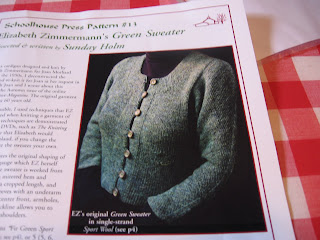Exhausted as I am from Olympic training and 'performing', last night, needles in mid-stitch, I fell asleep. During prime Olympic- viewing- knitting time!!
You would have thought that Fred, sitting right beside me, would have realized the importance of every knitting minute and given me a shake. Instead, he let me sleep!! What kind of support is that?
Despite falling asleep way too early, I did manage to knit to the sleeve steek area. The steeks have now been created! S.J. commented to ask what the heck I meant by 'sleeve steeks'. I understand her confusion. I was certainly confused when I read the pattern. In the interest of spreading Olympic fever everywhere, here is my ' picture's worth a thousand words' explanation.
31 underarm stitches on hold. 5 steek stitches cast on.
And with words. EZ's Green Sweater is knit in the round. Often, knit-in-the-round sweaters will have the knitter knit in the round until the armholes, then separate front and back. EZ, however believes in knitting in the round for the entire sweater. Right up to the shoulders. That of course creates a tube. Perfect for restraining hysterical Olympic knitters, but for normal wear, one does need sleeves.
That is where the sleeve steeks come in . I knit in the round up to the armhole, then put 31 stitches on hold for the underarm portion of the sleeves. EZ then tells the knitter to continue knitting in the round to the shoulder. When ready to knit the sleeves, which in this case are knit top down, I need to be able to access those 31 underarm stitches.
But if the stitches have been 'islanded off' by continuing to knit in the round until the top of the shoulder, how the heck will I open up the armhole to pick up stitches for the top-down sleeves? By cutting the sweater, that's how.
Sweater cutting is the knitter's equivalent of bungee jumping. A net is required.The knitters net is extra stitches. Called a steek.
Here's how I did it.
*Knit to armholes.
*Put 31 stitches on hold for the first armhole.
*Cast on 5 extra stitches. These five stitches are my safety net. I will cut from the shoulder down to the 31 underarm, on-hold stitches - right down the middle of those five stitches. (Surely I can keep the scissors within a five stitch span.)
*Knit to other armhole and repeat.
Three more inches of knitting and I will be at the neckline. There is another
bungee jump steek there.
Here it is. Lookin' good. I think I'm past the qualifying round. Tomorrow, phoney seams.

















































